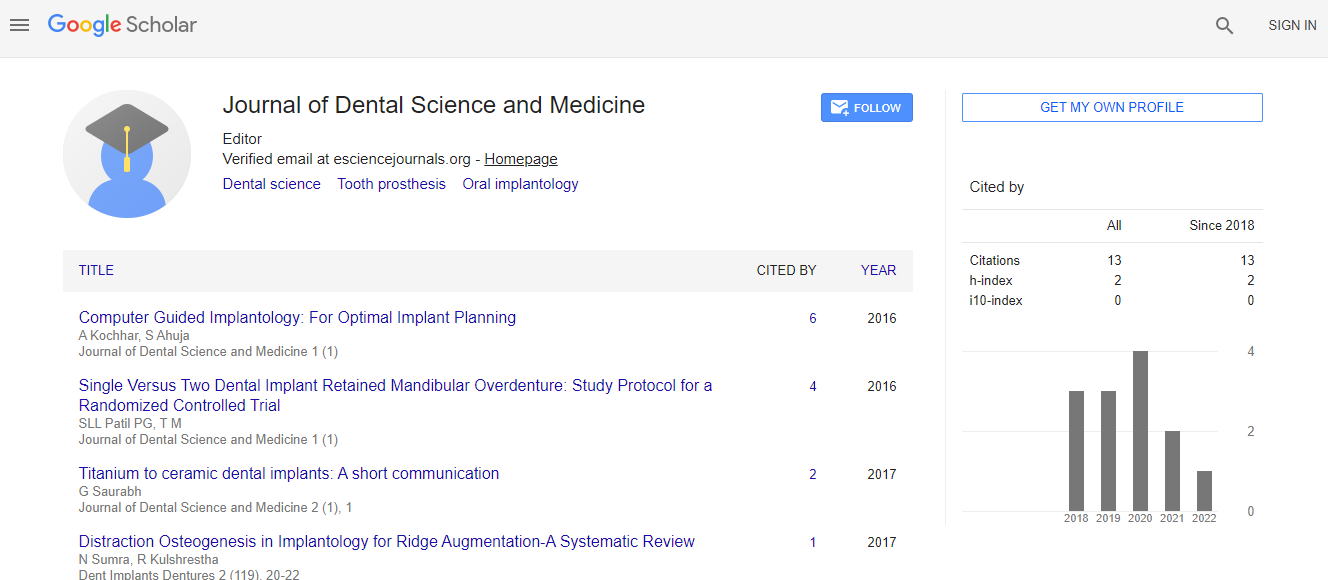Our Group organises 3000+ Global Conferenceseries Events every year across USA, Europe & Asia with support from 1000 more scientific Societies and Publishes 700+ Open Access Journals which contains over 50000 eminent personalities, reputed scientists as editorial board members.
Open Access Journals gaining more Readers and Citations
700 Journals and 15,000,000 Readers Each Journal is getting 25,000+ Readers
Google Scholar citation report
Citations : 13
Journal of Dental Science and Medicine received 13 citations as per Google Scholar report
Indexed In
- RefSeek
- Hamdard University
- EBSCO A-Z
- ICMJE
Useful Links
Recommended Journals
Related Subjects
Share This Page
Effect of cone-beam computed tomography voxel size on detection of vertical periodontal bone defects
28th American World Dentistry Congress & 35th Annual World Dentistry Summit & 8th International Conference on Prosthodontics & Orthodontics
Masoumeh Eftekhar
Tehran University of Medical Sciences, Iran
ScientificTracks Abstracts: Dent Implants Dentures
Abstract
Objectives: Finding the best voxel size for the detection of vertical periodontal bone defectswith minimum patient radiation dose is a priority. This study sought to assess the effect of conebeam computed tomography (CBCT) voxel size on the detection of vertical bone defects. Materials and Methods: In this in vitro, experimental study, 31 vertical defects including 2 one-wall, 12 two-wall, and 17 three-wall defects were randomly created in the maxilla and mandible of four sheep skulls with the associated soft tissue using round and needle burs. Forty sound sites were considered as the control group. The CBCT scans were obtained from the skulls with 0.150 and 0.300 mm3 voxel sizes and 8 x 11 cm2 field of view (FOV). The images were randomly evaluated by two oral and maxillofacial radiologists and two periodontists, and their findings were recorded. The inter-rater observer agreement (weighted kappa), sensitivity and specificity values were calculated for each voxel size. Comparisons were made using paired t-test. Results: The two voxel sizes had no significant difference in detecting one-wall and twowall defects (P>0.05). But the smaller voxel size was significantly superior for detecting three-wall defects (P=0.001). The inter-rater observer agreement was unfavorable (kappa < 0.6) for the detection of all three defect types. Conclusion: In general, increasing the image resolution by decreasing the voxel size increased the sensitivity and reduced the specificity of CBCT for detection of vertical bone defects, and is only recommended for detection of three-wall defects.Biography
Dr. Eftekhar studied General Dentistry at Tehran University of medical sciences, Tehran, Iran for almost 6 and a half years and graduated as a general dentist in 2020. She received her doctoral degree on the 5th of August 2020 at the same institution. She is interested in the field of periodontology and surgery and has done some researches in this field.

 Spanish
Spanish  Chinese
Chinese  Russian
Russian  German
German  French
French  Japanese
Japanese  Portuguese
Portuguese  Hindi
Hindi 